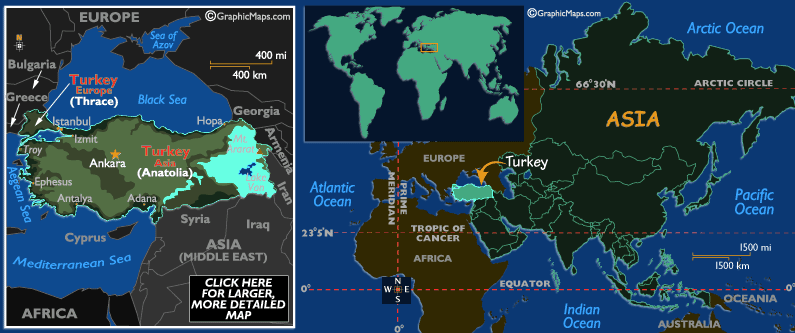
BANKNOTES OF TURKEY
The following banknotes are available for your viewing pleasure!
Click on the thumbnails to enlarge.

BANKNOTES OF TURKEY
The following banknotes are available for your viewing
pleasure!
Click on the thumbnails to enlarge.
Old Turkish Lira
Up until 2005 the Turkish currency was the Turkish lira or in Turkish; Türk
lirası, it was often referred to as just lira but almost always referred
to as the Turkish lira outside Turkey, to avoid confusion with the better-known
former Italian lira. Prices in Turkey is old lira were usually written using the
abbreviation TL, which preceded the price, The ISO 4217 code for the old Turkish
lira was TRL.
The gold lira was introduced in 1843, weighing 7.216 g with a fineness of
91.67%, that is, 6.6 g of gold. In a bimetallic system, it was defined as equal
in value to 100 silver kuruş of 1 g of silver (1.2027 g at 83%), first minted in
1844, at a ratio of 15.09. Each kuruş was divided into 40 para. There were 5,
10, and 20 kuruş coins; the 20-kuruş coin was called a mecidiye. All coinage
minted until 1922 followed these standards.
Before the lira, the monetary unit used by the Ottoman Empire was first the akçe,
later to be replaced by the kuruş (piastre), with the para as a subunit (1 para
being equal to 3 akçe, thus 1 kuruş equal to 120 akçe). Having begun as a large
silver coin, by the late 1800s the kurus had shrunk to a small silver coin.
The Banque Imperiale Ottomane (Imperial Ottoman Bank) first issued paper
currency denominated in kuruş, with values ranging from 5 to 5000 kurus. The
denomination switched from kuruş to lira in the mid 1870s. Denominations ranged
from 5 kuruş to 1000 lira, with the 50,000-lira banknote specially prepared to
fund the issue of small change (1- and 2½-kurus) notes.
World War I saw Turkey effectively depart from the gold standard with the gold
lira being worth about nine lira in paper money by the early 1920s.
The Turkish Republic replaced the older imperial Ottoman paper liras with the
Turkish lira being reissued as a mid size silver coin. Turkish lira notes were
also introduced in denominations of 1, 2½, 5, 10, 50, 100, 500 and 1000 lira.
Each note carried the portrait of Mustafa Kemal Atatürk.
After Atatürk's death in 1938, new notes were prepared with the portrait of
President İsmet İnönü. Atatürk reappeared on a subsequent series of notes in the
early 1950s.
Chronic inflation from the late 1970s onward saw the Turkish lira sharply
depreciate against other major currencies. The table below gives a snapshot of
the decline in the value of the Turkish lira against the United States Dollar
from 1933 through 2001.
| YEAR | Turkish Lira vs. US Dollar |
| 1933 | 2 Turkish Lira |
| 1966 | 9 Turkish Lira |
| 1980 | 90 Turkish Lira |
| 1988 | 1,300 Turkish Lira |
| 1995 | 45,000 Turkish Lira |
| 2001 | 1,650,000 Turkish Lira |
The Turkish lira slid in value to such an
extent that one original gold lira coin could be sold for approximately
120,000,000 Turkish lira prior to the 2005 revaluation.
In its last few years the Turkish lira stabilized and even rose against the U.S.
dollar and the Euro. In December 2004, it traded at about 1,350,000 lira to 1
U.S. dollar, and about 1,850,000 lira per Euro. The Guinness Book of Records
ranked the Turkish lira as the world's least valuable currency.
New Turkish Lira "Yeni Türk Lirası"
The new Turkish lira is the current currency of Turkey and of the de
facto state of the Turkish Republic of Northern Cyprus. Introduced on 1
January 2005, it is equivalent to 1,000,000 old Turkish lira. New
banknotes were issued denominated in New Turkish Lira, the old banknotes
circulated alongside the new currency for all of 2005. Old Turkish lira
banknotes were legal tender until the end of 2005, and may be exchanged at the
Central Bank until the end of 2015. The new Turkish lira is
divided into 100 new kuruş. The ISO 4217 code for the new Turkish
lira is TRY. Prices are expressed using the abbreviation YTL, which short for "Yeni
Türk Lirası", Turkish for "New Turkish Lira"
Banknotes are currently issued in denominations of 1 YTL, 5 YTL, 10 YTL, 20 YTL,
50 YTL and 100 YTL. The Bank of Turkey has indicated that it has plans to issue
a new 200 YTL banknote, although the new denomination is not expected for a
couple of years. It is also planned to drop the word "New" from the currency
name in 2009.
Coins currently in circulation come in denominations of 1, 5, 10, 25, 50 new
kuruş, and 1 YTL. The design of the 50 kuruş and 1 lira coins, much to the
dismay of the European Central Bank, clearly resembles that of the one and two
euro coins respectively. This has caused confusion in the euro zone. Also, it
has caused trouble to businesses using vending machines, particularly at
airports in the euro zone. Since numerous vending machines at the time accepted
the 1 lira coin as a two euro coin, vending machines affected had to be quickly
upgraded at the expense of the operators. Two euros is worth roughly four times
more then a 1 lira coin.
BACK TO HOMEPAGE
Page created: 28 August 2006
Last Update: 28 August 2006
Maps are provided by Graphic Maps
All maps provided by them bear their copyright information.
All scans shown here are of actual notes from my collection unless otherwise
noted.
Images and content unless otherwise noted are copyrighted.
(c) 2006 Will's Online World Paper Money Gallery